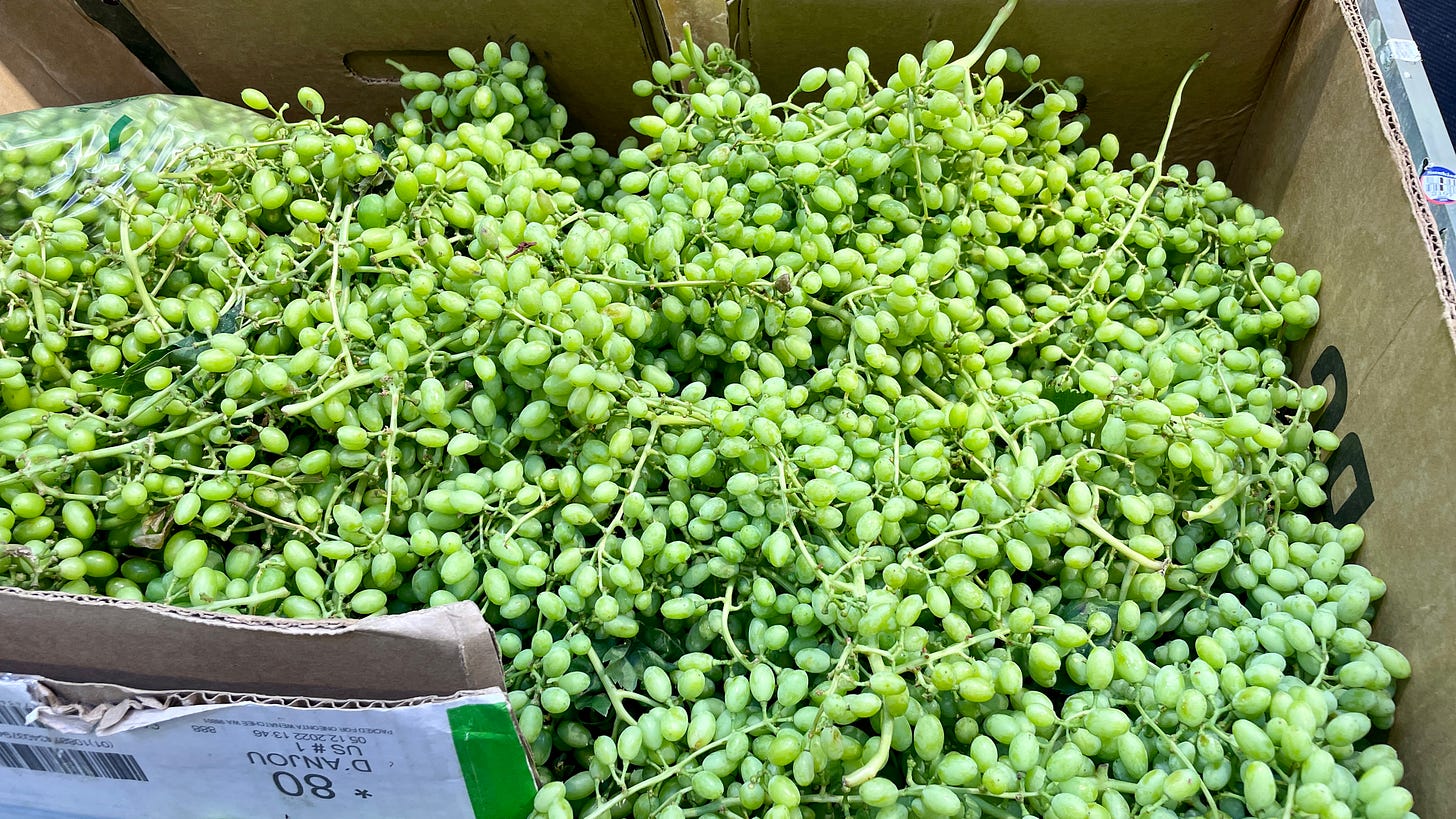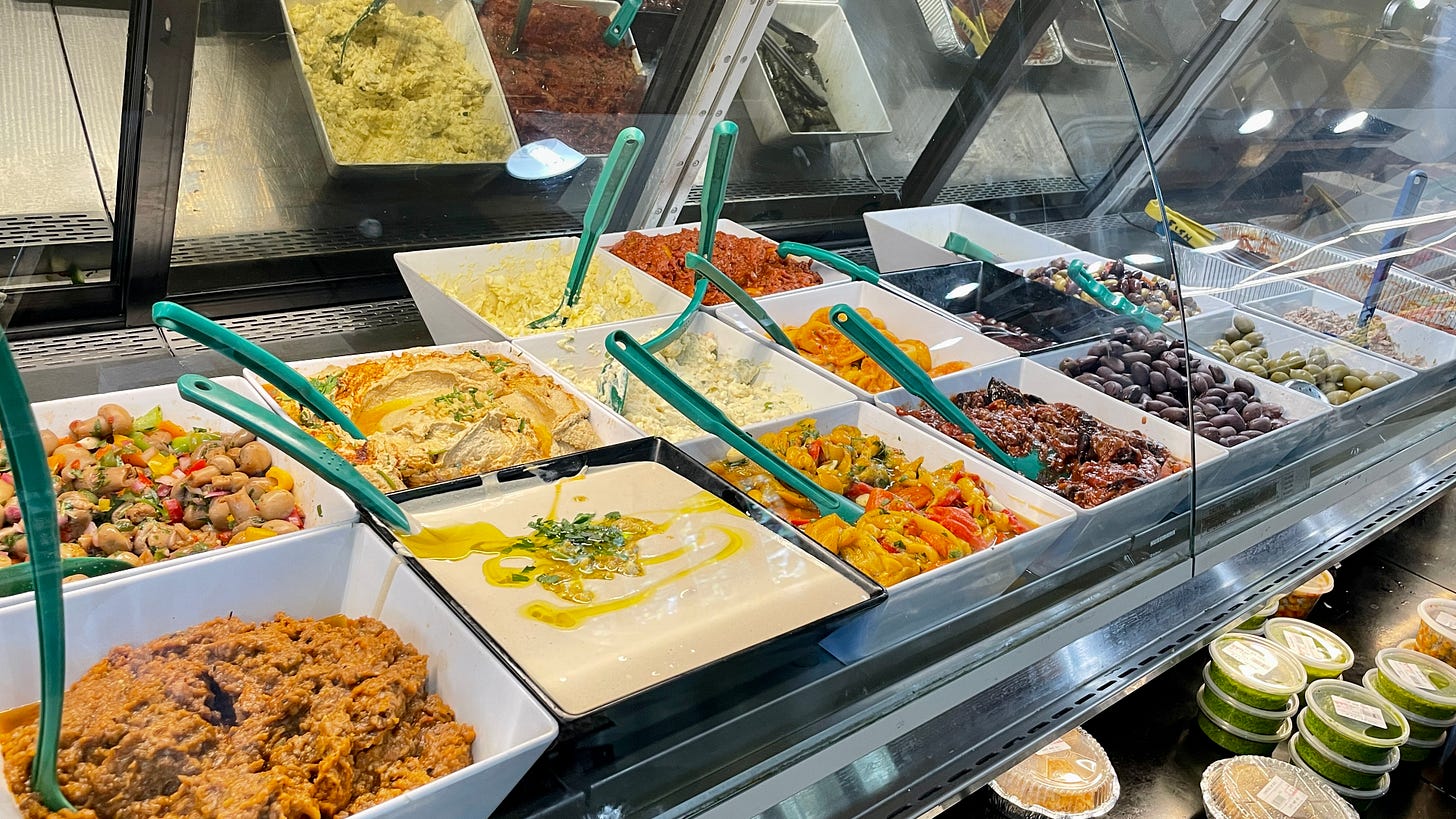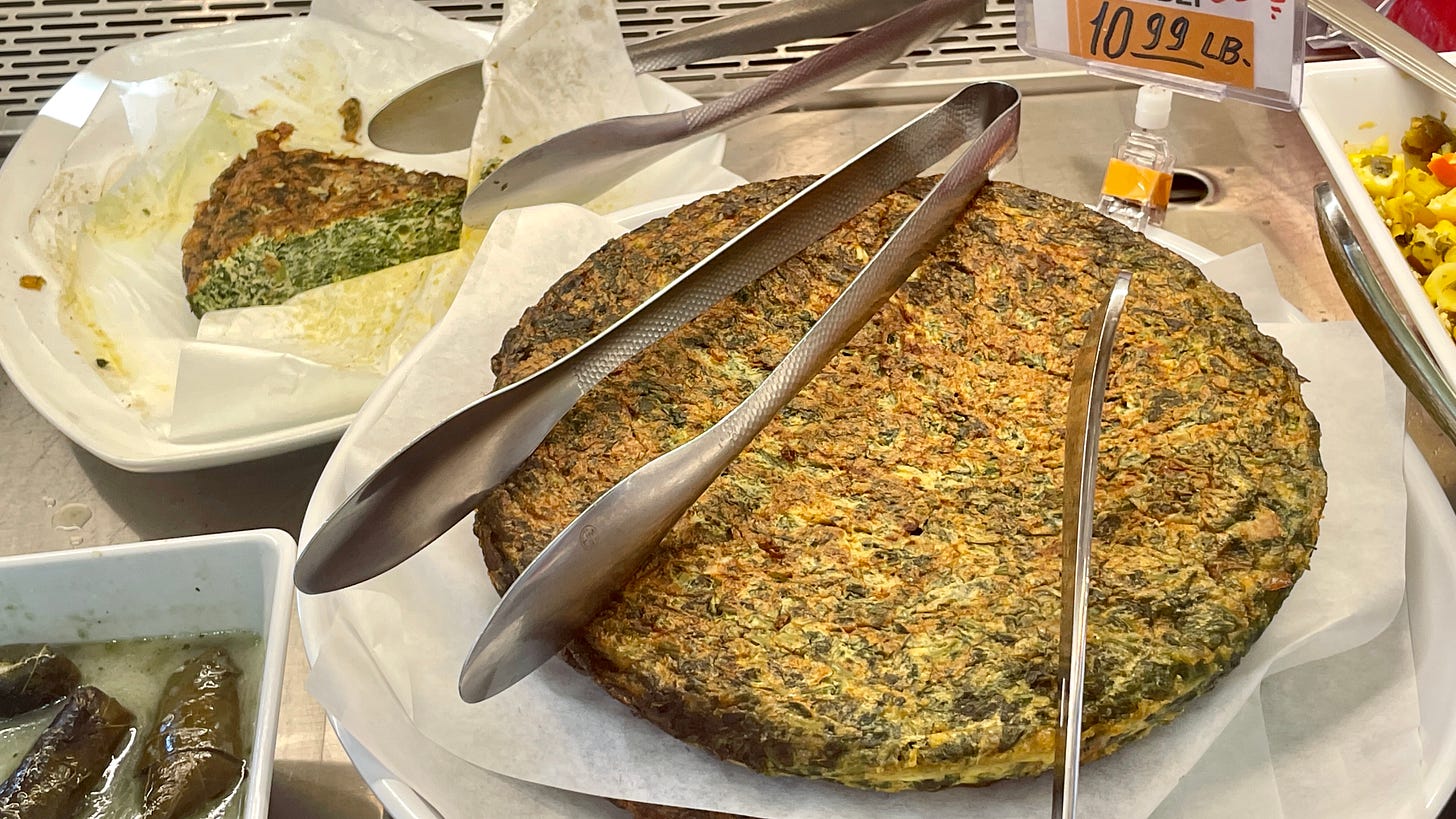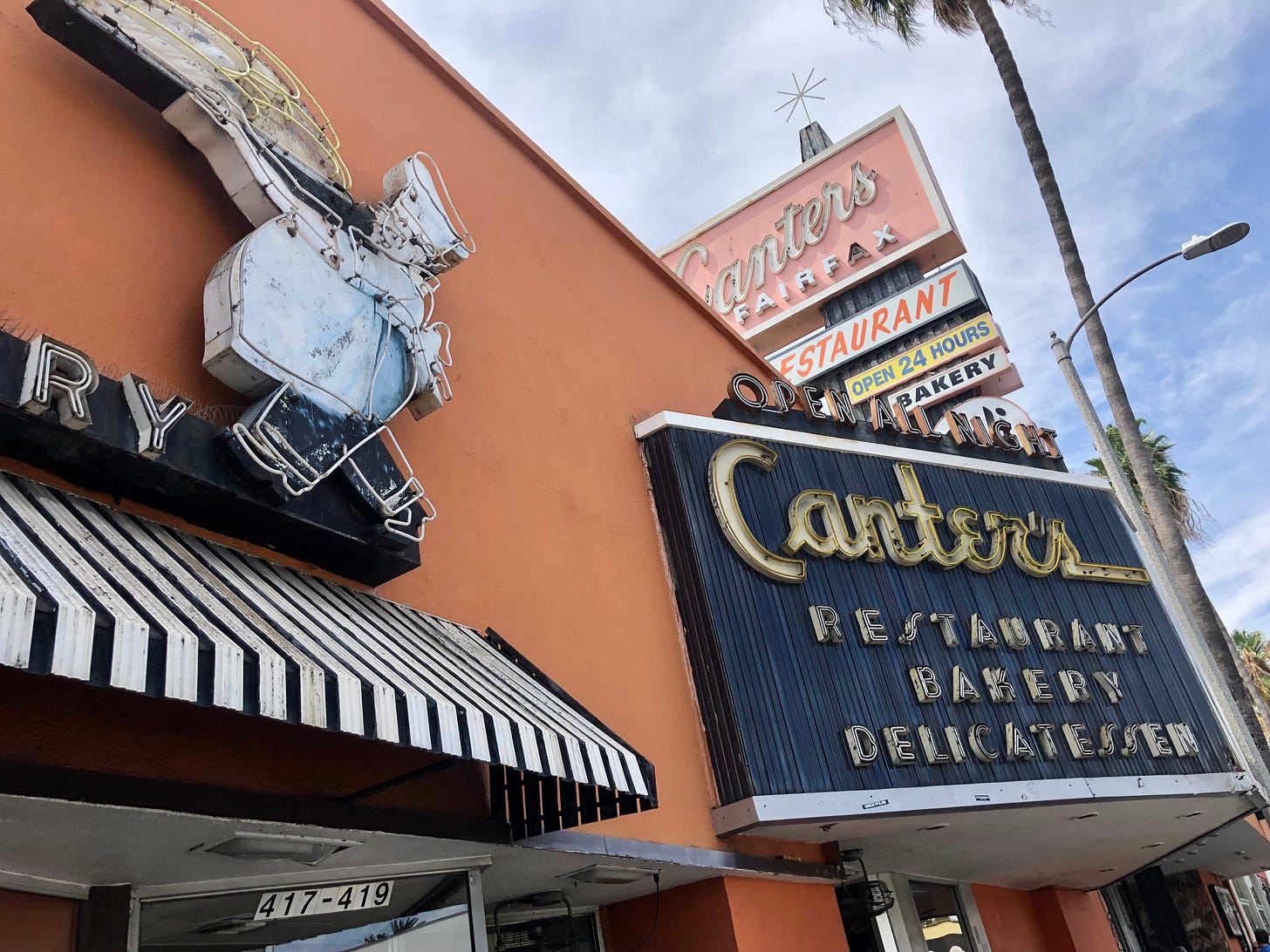Taking a Bite Out of Kosher L.A.
A visit to 2 busy markets, plus kuku sabzi, sour grapes and luscious dates
Do you eat kosher?
I read recently that even though Jews represent less than 2% of the American population and few of them follow Jewish dietary laws, more than 40% of packaged goods and beverages in the U.S. are certified kosher.
When you shop at your local Ralphs, Safeway or Trader Joe’s, chances are many of the products have a kosher symbol on the outside, though you may never notice it. Examples include Oreo cookies, once made with lard (a no-no for Jews who keep kosher), which went through an arduous three-year “koshering” process to gain certification through the Orthodox Union.
The OU claims to have certified more than a million products at 13,000 plants worldwide—among them, Hershey’s, Chobani and Bacardi.

The kosher certification appeals not only to those who are Jewish, but to many others who see it as a mark of quality, cleanliness and purity. The word “kosher” is often used to point out something (not always a food!) that is right and correct—or not, as in, “That contract you just signed to give away half your assets doesn’t sound kosher to me.”
(To learn more about how products get a kosher certification, click here.)
You may wonder why should you make a special trip to a kosher grocery, especially if you, like me, don’t keep a kosher home? Perhaps simply because you’re curious and, if you’re lucky, you have a knowledgeable guide to take you there! Also, once you’re there, you never know what offbeat products you might stumble upon—and what interesting culinary rabbit holes they may send you down!

My guide one Friday morning a few weeks ago was Risa Hyman, wife of our temple’s rabbi emeritus, Mark Hyman. Both are dedicated foodies who suggested after my recent visits to Fred’s Bakery and Langer’s Deli that there were some popular kosher markets that I might want to check out. Along the way, I could pick up some great challah and corn rye to satisfy my bread-obsessed family (including me!).
The two markets, Elat Market and Glatt Mart, sit side by side on busy Pico Boulevard, a street filled with Jewish businesses and restaurants. A wide cross-section of Jewish and non-Jewish Los Angeles patronizes these groceries, which often carry lower-priced and/or fresher produce, many varieties of popular items like hummus, pickles, kosher meats, breads, dried fruits and nuts and deli specialties, including traditional items like matzo balls, stuffed cabbage and chopped liver, and less traditional ones like sushi.
For those who keep kosher, these markets “are the closest thing we can find to a Ralphs or Albertson’s,” Rabbi Mark tells me.
The two are also gathering places for L.A.’s large Persian Jewish community (Persian is the preferred term to Iranian for many), which numbers more than 50,000, and offer a wide variety of Persian and other Middle eastern specialty foods that attract both Jewish and non-Jewish customers.
For me, it’s eye-opening to discover such unusual (for me) offerings, as sour grapes—ghooreh in Farsi—a seasonally available item that is used in a popular Persian eggplant and tomato stew, called khoresh bademjan ba ghooreh. I found several versions of the stew but am drawn to this recipe from Family Spice. If you can’t find fresh sour grapes, the author says you can use another ingredient popular in Persian and other Middle Eastern dishes, dried limes (Lime Omani), or lemon juice.

Risa, who visits the markets about every two weeks, usually on a Friday morning to pick up items for Shabbat and for the week, says each has its plusses and minuses.
She likes the Persian pistachios, roasted almonds, and pitted prunes at Elat, but prefers the dried apricots from Glatt. She usually buys chicken, lamb chops and ground beef at Glatt, though she also likes Elat’s pre-seasoned chicken kebabs. She shops produce at both, but says the hummus, tahini and hearts of palm are cheaper at Elat, while Glatt has the better deli section.
I fell in love with some of the nuts and dried fruits sold at Elat, particularly the roasted lemon-flavored almonds and some intensely sweet, soft Rotab dates, which one site calls “arguably the best dates in the world.” After eating several and nearly fainting with pleasure (and the sugar rush!), I can’t disagree!
One thing Risa is particularly fond of is a Persian specialty called kuku sabzi. A dense, pie-shaped dish made with herbs, eggs and vegetables, it bears some resemblance to an omelet or a frittata but has a much higher ratio of greens to liquid. It’s sold in wedges at the deli counter at Elat. I bought a triangle of it on the day we visited, then returned another day for more, plus bunches of parsley, cilantro and dill to attempt to make it myself.
The young man behind the counter cautioned me that it isn’t so easy to make. “Most Persian food takes a lot of work.”
Samin Nosrat’s kuku sabzi recipe from the New York Times and an alternate version from The Mediterranean Dish seem to prove his point. Nosrat’s preparation calls for hand-chopping a pound each of parsley and cilantro and a large bunch of fresh dill, plus two leeks, romaine lettuce and barberries—little sour red berries prevalent in many Persian dishes. The second recipe includes walnuts, omits the leeks, and preps the herbs in a food processor, which sounds a lot easier! Nosrat’s book Salt Fat Acid Heat contains yet another version using chard. I’m not quite sure which one to make. Perhaps I’ll mix elements of all three and report back in a future newsletter. Stay tuned!
A side trip to Diamond Bakery on Fairfax

After visiting the two kosher groceries on Pico, Risa took me to the area near Fairfax Avenue where she grew up—a neighborhood once considered the heart of Jewish Los Angeles.
It’s a trip down memory lane for Risa, who still gets together to reminisce over lunch with friends she met at Fairfax High School.
“Almost everyone who went there was Jewish,” she said. “When there was a Jewish holiday they would close because nobody went to school.”
As a little girl, she remembers accompanying her father to shop for sliced kosher meat at a grocery on Fairfax Avenue that’s long gone. She’d get a little jelly candies as a treat.
Although many of the kosher markets and Judaica shops have disappeared and the neighborhood, once largely Jewish, is more diverse now, Canter’s, the popular 91-year-old Jewish-style deli, is still around and remains family-owned after four generations! There are other kosher markets there that Risa tells me I should definitely visit on another day.
Diamond Bakery, where Risa and I stop for pastries and challah, is also a neighborhood stalwart after 76 years.
Even though I’ve already bought a pretzel challah from Elat Market, I can’t resist buying a big beautiful egg challah and a sliced corn rye, plus some melt-in-your-mouth chocolate hazelnut cookies. The pastry cases are filled with Jewish standards like hamantaschen and rugelach. I’m told that the baked goods are made with kosher ingredients, yet Diamond can’t be certified kosher by the rabbinical authorities because it doesn’t close for Shabbat.
Final thoughts
Although I write a lot about Jewish food and am proud of my heritage, I don’t keep a kosher home. To do so would require a separate set of dishes for milk and meat—and a third set for Passover. While I’m fairly sure that both my immigrant parents grew up in kosher homes, that changed after they settled in California in the late 1940’s. The rules of kashrut—the set of dietary laws dealing with types and preparation of foods Jews are permitted to eat—were relaxed. No pork, bacon or shellfish, appeared on our table, but we drank milk, even when there was meat—and the meat came from a local butcher, not a kosher market, of which there were none in my hometown, Palo Alto.
So, no, I don’t think I’ll be following a strictly kosher diet any time soon. And yet, visiting these markets opens up a small wonderland of possibilities—new foods and recipes to try, new ideas to ponder, such as why kosher foods have become so prevalent (perhaps I’ll write more on that in a future post!).
In a time when there’s so much that sparks fear and the impulse to withdraw from the world, it’s nice to find something to spark curiosity and inspiration, whether it’s food-related or not. It may be as simple and seemingly insignificant as discovering a new ingredient, like barberries, or coming across a tiny heart image on a leaf while taking a walk.
How about you? Have you encountered a new recipe or ingredient or had an experience (non-food-related is okay too!) that sent you down a rabbit hole of curiosity or discovery? I’d love to hear about it.
Thanks for taking the time to read, comment, share and like this newsletter. And thanks for being a subscriber—or for becoming one!
See you next time!
.













Just another wonderful article!! I’m not Jewish but just love the food and that neighborhood.Last Sunday 6 of us had a long brunch at Running Goose in Hollywood starting with a appetizer the owner called Ugly carrots, if you don’t like carrots these will change your mind. One of many amazing tastes after another, a vacation out of the South Bay which you only have to forget the traffic, what’s new.
Wow...3 year koshering process? That's crazy! Do you have any other examples of other companies who had to go through the same process?